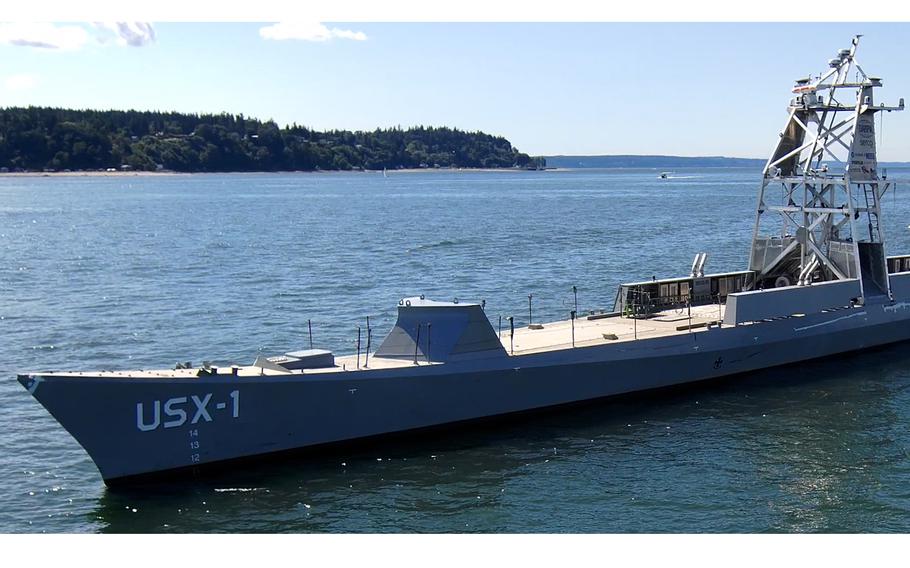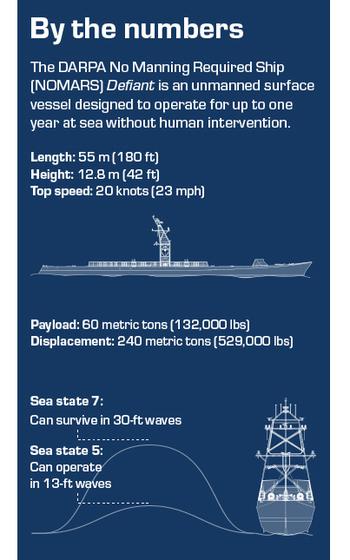
The USX-1 Defiant ship cruises in Puget Sound near Seattle in the summer of 2025. (DARPA)
SEATTLE — A previously unseen vessel cruising Puget Sound has been the talk of ship spotters, nautical bloggers, local television and newspapers as far away as the East Coast.
“Images of the odd-looking, 180-foot ship escorted by a tugboat through the Saratoga Passage in Puget Sound emerged on Reddit earlier this week,” the New York Post reported in March.
The vessel had few markings, a blank, white-covered superstructure and no visible crew.
“A mysterious warship with no one aboard was recently seen in waters off of Washington state,” wrote the WION news site.
The Pentagon confirmed soon after that the vessel was a project of the Defense Advanced Research Projects Agency.
On Aug. 11, the Navy went public with details on the ship, including photographs of a bottle of champagne being smashed across its bow as part of a naming ceremony at a Puget Sound shipyard in Everett, Wash., north of Seattle.
“DARPA has marked a traditional naval milestone with the christening of USX-1 Defiant, a first-of-its-kind autonomous, unmanned surface vessel designed from the ground up to never accommodate a human aboard,” the agency reported.

(DARPA)
The 240-metric ton vessel, built by Nichols Brothers Boat Builders and Serco Maritime at a small shipyard on Whidbey Island in Puget Sound, is a demonstration model for the Pentagon’s No Manning Required Ship, or NOMARS, program. It’s designed to operate autonomously in open seas for up to a year without needing human maintenance.
The Navy could use unmanned vessels such as the Defiant on missions that might risk casualties on crewed ships, DARPA said.
At an U.S. Naval Institute conference Friday in Annapolis, Md., on the future of unmanned vessels, top Navy officials said the Defiant and other uncrewed ships are a key to match the number of Chinese ships and their capabilities in the Indo-Pacific region.
“That is the newest thing, the most complicated thing we’re working on,” said Rear Adm. Derek Trinque of the Navy’s Surface Warfare Division.
Capt. Garrett Miller, commander of Surface Development Group One, the San Diego-based command of the Navy’s experimental unmanned fleet, was more succinct.
“We definitely want unmanned. Period. I mean, it’s that simple,” he said.
The Defiant was built with a $25 million project development budget, according to the U.S. Naval Institute.
Congress just approved more than $2 billion for Navy uncrewed ship programs overall, primarily in the reconciliation bill that supplemented defense spending in addition to spending planned in the National Defense Authorization Act, annual legislation that sets expenditures and policies for the Defense Department.
The Defiant design “aims to revolutionize naval architecture by eliminating the need for human crew aboard ships,” the Pentagon said in a statement last week.
The ship has no portals and doors, corridors, gangplanks, ventilation, bridge or other open spaces that would be needed for a crewed ship.
“Defiant is a tough little ship and defies the idea that we cannot make a ship that can operate in the challenging environment of the open ocean without people to operate her,” said Greg Avicola, NOMARS program manager. “She’s no wider than she must be to fit the largest piece of hardware, and we have no human passageways to worry about.”
The simplified hull design also will allow for rapid production if the Pentagon approves the project following ongoing sea trials. The project is under DARPA and would shift to the Navy later if tests go as planned. At that point, the Defiant would be officially commissioned as a Navy ship. Defiant would operate under the Navy’s Unmanned Maritime Systems Program Office, according to DARPA.
The Defiant is not armed, but the Pentagon has released concept plans that would include missile systems. Weapons control would be handled by humans from remote locations or nearby crewed vessels, according to the Pentagon
The unmanned surface vessel Ranger first test-fired a missile controlled from a nearby ship in 2021. The Ranger is homeported at Naval Base Ventura County north of Los Angeles.
The Navy also issued a “pre-solicitation notice” last month seeking defense industry submissions for a Modular Attack Surface Craft that could travel at least 25 knots up to 2,500 nautical miles in heavy seas — fast enough and durable enough to keep pace with a deployed aircraft carrier strike group.
The proposed vessel would carry two 40-foot containers, which could be anything from supplies to a missile launcher capable of firing up to four missiles, according to the Navy.
DARPA said the Defiant model could be produced and maintained at smaller port facilities and shipyards that can work on yachts, tugboats, and other small- to medium-size commercial vessels.
The ships will not have crews, but they will be operated remotely by officers and sailors. The Navy in February created the robotics warfare specialist rating for crew who can operate and maintain the new ships and weapons.